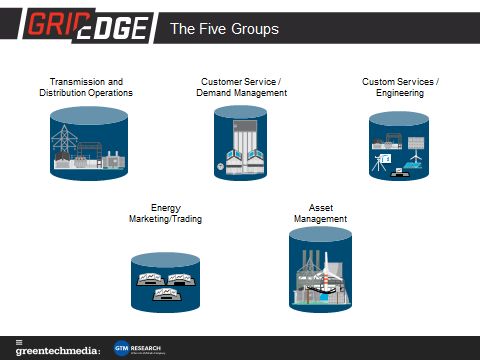The Grid Edge Executive Council just convened for its third meeting this year to discuss the increased importance of grid edge analytics in the utility industry and in next-generation power systems. GTM defines "grid edge analytics" as software systems and platforms that either:
- Utilize data generated and transmitted from the edge of the grid to improve existing processes, or
- Utilize data storage and processing at the edge of the grid (from the distribution substation to the customer) to drive decision-making via distributed intelligence.
Relying on council members' experience, we asked participants to identify the most valuable use cases each member is deploying today. As expected, several members highlighted asset management and health technologies and economic project evaluation tools.
Later in the meeting, we broke up into five groups, each representing a siloed service provided by utilities or third-party service providers, as shown in the chart below.

Source: GTM Research
Members were tasked with first identifying the key business challenges for that siloed service group and then identifying the three most valuable use cases for that particular service provider. This left the council with nearly twenty different use cases to decide between. Each member then received three votes to select what they viewed as the most valuable use cases.
To our surprise, the council voted for a strong focus on grid analytics, with each of the top five use cases falling squarely into transmission and distribution analytics.
The top three use cases focused on the historical near-real-time and real-time modeling, simulation and optimization of the distribution grid. This class of modeling software is nothing new for utilities, but the application of software to simulate grid conditions and make real-time decisions about local system stability in a multi-asset environment is a step-change in the complexity of these systems. The lack of simulation capabilities has severely limited utilities' ability to evaluate lowest-cost grid upgrade options or correctly value dynamic assets such as solar installations, battery storage, distributed wind, dynamic volt/VAR control for CVR or renewable integration, or low-voltage power electronics.
With California’s AB 327 distribution grid planning mandates on the horizon, and New York’s REV initiative beginning to take shape, these solutions are becoming more important than ever for utilities and public utility commissions seeking to evaluate potential and formulate policies to assess various upgrades on an unbiased platform. GTM Research's Ben Kellison previously covered these solutions and their potential to enable targeted deployment of advanced low-voltage grid power electronics.
Below is the complete top ten list of grid edge analytics use cases, as voted by council members.

* Note: Each member received 3 votes allowing for a total of 300 percent
Source: GTM Research
GTM Research analysts were surprised that some notable applications ranked so low. In particular, they expected some form of forecasting and segmentation to rank higher on the list.
In an interview, Kellison noted that forecasting is important across energy marketing and trading, generation, asset management, transmission and distribution operations, and customer service. He said that it not only provides information on what plants should dispatch, but it also enables anomaly detection to identify losses, equipment failures and inefficiencies, and can manage customer billing expectations.
Similarly, the importance of customer segmentation of energy products is of strong interest in the market today, but it was overshadowed by larger system stability and technical planning, simulation, and operation of distributed energy resources.
Grid edge analytics' importance will continue to increase over the coming years as utilities derive value from the many use cases enabled by grid edge data and processing power on the grid.
***
The council will meet next on December 11 in San Diego following our U.S. Solar Market Insight Conference on the topic of The Future of the Utility.



